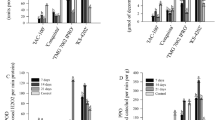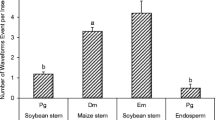Abstract
Greenhouse and laboratory studies were conducted to evaluate feeding activity and superficial damage to soybean seed by the brown-winged stink bug, Edessa meditabunda (F.), and the Neotropical brown stink bug, Euschistus heros (F.). Soybean plants (cv. BRS 282), at R6 stage of development were used. Thirty pairs of each species were used individually for 48 h. Two daily observations (9:00 AM and 3:00 PM) were taken to record the number of bugs (feeding/resting) on plant parts. Harvested seeds imbibed in tetrazolium solution were photographed for measurement of the damaged surface. Adult E. meditabunda significantly preferred soybean stems (19.7 bugs) to pods (2.7). Feeding/resting was similar at 9:00 AM (mean number of 28.0 bugs) and 3:00 PM (24.3). Euschistus heros equally fed/stayed on stems (7.3 bugs) and pods (6.9), although most bugs (12.3) remained on the cage net; feeding/resting on all plant structures amounted to 13.7 bugs at 9:00 AM and 17.7 bugs at 3:00 PM. Amylase activity was greater for E. heros (41.61 ± 0.89 U/mg) and almost none for E. meditabunda (2.35 ± 0.14 U/mg). The superficial damage to seeds was significantly greater for E. meditabunda (22. 9 mm2) compared to E. heros (12.5 mm2). However, E. meditabunda caused less shrinkage of the seed tegument, while E. heros damage was deeper and seeds showed reduction in size.




Similar content being viewed by others
References
Corrêa-Ferreira BS, Azevedo J (2002) Soybean seed damage by different species of stink bugs. Agric Forest Entomol 4:145–150
Costa EC, Link D (1977) Danos causados por algumas espécies de Pentatomidae em duas variedades de soja. Rev Centr Cienc Rur 7:199–206
Daugherty DM, Neustadt MH, Gehrke CW, Cavanah LE, Williams LF, Green DE (1964) An evaluation of damage to soybeans by brown and green stink bugs. J Econ Entomol 59:719–722
Depieri RA, Panizzi AR (2010) Rostrum length, mandible serration, and food and salivary canals area of selected species of stink bugs (Heteroptera, Pentatomidae). Rev Bras Entomol 54:584–587
Depieri RA, Panizzi AR (2011) Duration of feeding and superficial and in-depth damage to soybean seed by selected species of stink bugs (Heteroptera: Pentatomidae). Neotrop Entomol 40:197–203
França-Neto JB, Krzyzanowski FC, Costa NP (1998) O teste de tetrazólio em sementes de soja. Londrina, EMBRAPA-CNPSo, Documentos 116 72 p.
Galileo MHM, Heinrichs EA (1979) Danos causados à soja em diferentes níveis e épocas de infestação durante o crescimento. Pesq Agropec Bras 14:279–282
Galileo MHM, Gastal HAO, Grazia J (1977) Levantamento populacional de Pentatomidae (Hemiptera) em cultura de soja (Glycine max L. Merr.) no município de Guaíba, Rio Grande do Sul. Rev Brasil Biol 37:111–120
Hori K (2000) Possible causes of disease symptoms resulting from the feeding of phytophagous Heteroptera, p. 11-35. In: Schaefer CW, Panizzi AR (eds) Heteroptera of economic importance. CRC Press, Boca Raton, p 828
Hori K (1972) Comparative study of property of salivary amylase among various heteropterous insects. Comp Biochem Physiol 42B:501–508
International Union of Biochemistry (1961) Report of the comissiono n enzymes of the International Union of Biochemistry. Pergamon Press, Oxford, p 15
McPherson RM, Douce GK, Hudson RD (1993) Annual variation in stink bug (Heteroptera: Pentatomidae) seasonal abundance and species composition in Georgia soybean and its impact on yield and quality. J Entomol Sci 28:61–72
Noelting G, Bernfeld P (1948) Sur les enzymes amylolityques. III. La B-Amylase: dosage d'activité et contrôle de l'absence d' a-amylase. Helv Chim Acta 31:286–290
Nunes MC, Corrêa-Ferreira BS (2002) Danos causados à soja por adultos de Euschistus heros (Fabricius) (Hemiptera: Pentatomidae), sadios e parasitados por Hexacladia smithii Ashmead (Hymenoptera: Encyrtidae). Neotrop Entomol 31:109–113
Panizzi AR (2004) Neotropical brown stink bug, Euschistus heros (F.) (Hemiptera: Heteroptera: Pentatomidae). In: Capinera JL (ed) Encyclopedia of entomology. Kluwer Academic Publishers, Dordrecht, The Netherlands, p 1545p
Panizzi AR, Machado-Neto E (1992) Development of nymphs, and feeding habits of nymphal and adult Edessa meditabunda (Heteroptera: Pentatomidae) on soybean and on sunflower. Ann Entomol Soc Am 85:477–482
Panizzi AR, Corrêa BS, Gazzoni DL, Oliveira EB, Newman GG, Turnipseed SG (1977) Insetos da soja no Brasil. Embrapa, CNPSo, Bol Tec 1:20p
Panizzi AR, Smith JG, Pereira LAG, Yamashita J (1979) Efeitos dos danos de Piezodorus guildinii no rendimento e qualidade da soja. Anais Seminário Nacional de Pesquisa de Soja 1 Londrina PR v 2 p 59–78.
Pereira PRVS, Salvadori JR (2008) Aspectos populacionais de percevejos fitófagos ocorrendo na cultura da soja (Hemiptera: Pentatomidae) em duas áreas do norte do Rio Grande do Sul. Embrapa Trigo, Comunicado Técnico 253, 10 p.
Rizzo HFE (1971) Aspectos morfológicos y biológicos de Edessa meditabunda (F.). Rev Peruana Entomol 14:272–281
Saluso A, Xavier L, Silva FAC, Panizzi AR (2011) An invasive pentatomid pest in Argentina: the Neotropical brown stink bug, Euschistus heros (F.) (Hemiptera: Pentatomidae). Neotrop Entomol 40:704–705
SAS Institute Inc (1998) SAS user’s guide: statistics. Version 6.12. SAS Institute, Cary, NC, USA
Taylor GS, Miles PW (1994) “Osmotic pump” feeding by coreids. Ent Exp Appl 73:163–173.
Todd JW, Turnipseed SG (1974) Effects of southern green stink bug damage on yield and quality of soybeans. J Econ Entomol 67:421–426
Villas Bôas GL, Panizzi AR (1980) Biologia de Euschistus heros (Fabricius, 1798) em soja [Glycine max (L.) Merrill]. An Soc Entomol Brasil 9:105–113
Acknowledgments
We thank Paula L Mitchell, Winthrop University, USA, Paulo RVS Pereira, Embrapa Trigo, Brazil, and three anonymous reviewers for critically reading the manuscript. We also thank Walter Terra, University of São Paulo for the laboratory support in the salivary enzyme analysis. This research was supported by a scholarship to FACS, JJS, and RAD and research funds to ARP, from the National Council for Scientific and Technological Development (CNPq), Brazil.
Author information
Authors and Affiliations
Corresponding author
Additional information
Edited by Fernando L Cônsoli – ESALQ/USP
Rights and permissions
About this article
Cite this article
Silva, F.A.C., da Silva, J.J., Depieri, R.A. et al. Feeding Activity, Salivary Amylase Activity, and Superficial Damage to Soybean Seed by Adult Edessa meditabunda (F.) and Euschistus heros (F.) (Hemiptera: Pentatomidae). Neotrop Entomol 41, 386–390 (2012). https://doi.org/10.1007/s13744-012-0061-9
Received:
Accepted:
Published:
Issue Date:
DOI: https://doi.org/10.1007/s13744-012-0061-9




